The Many Caves
The Chauvet Cave
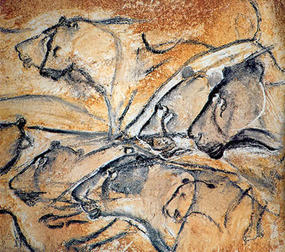
On December 18, 1994, Jean-Marie Chauvet led his two friends Eliette Brunel and Christian Hillaire on the Cirque d’Estre, towards the cliffs. There was a faint air current coming from a small opening at the end of a small cave. They all had a passion for speleology and had long stopped counting their discoveries. They went inside but did not have the correct equipment so; they ended up getting out at night. So, they gathered the correct tools and went back for discovery (The Cave Today).
They discovered a vast chamber with a very high ceiling. It was filled with glittering concretions. They continued onto another chamber as big as the first one. Then, they admired Chauvet cave’s first sightings. They discovered animal bones scattered on the floor. They examined almost all of the chambers and galleries. On the way out, Eliette noticed an amazing sight in the beam of her lamp that was a small mammoth drawn with red ochre on a rocky spur hanging from the ceiling. She cried out, “They were here!” and they began searching all of the walls with great attention. They discovered hundreds of paintings and engravings (The Cave Today).Chiaroscuro in art is characterized by strong contrasts between light and dark, usually bold contrasts affecting a whole composition...
They discovered a vast chamber with a very high ceiling. It was filled with glittering concretions. They continued onto another chamber as big as the first one. Then, they admired Chauvet cave’s first sightings. They discovered animal bones scattered on the floor. They examined almost all of the chambers and galleries. On the way out, Eliette noticed an amazing sight in the beam of her lamp that was a small mammoth drawn with red ochre on a rocky spur hanging from the ceiling. She cried out, “They were here!” and they began searching all of the walls with great attention. They discovered hundreds of paintings and engravings (The Cave Today).Chiaroscuro in art is characterized by strong contrasts between light and dark, usually bold contrasts affecting a whole composition...
Magura Cave
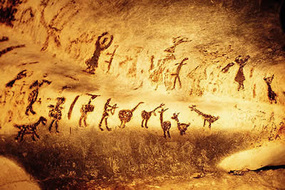
Magura Cave. Images of people and animals.
Magura cave is one of the biggest Bulgarian caves. It has been accommodated for tourists. There are many halls. Some of the halls are vast and adorned with beautiful rock formations. There have been remnants of prehistoric life found. There are traces of settlements dating back to the early Bronze Age and early Iron Age with ceramics, tools, and rock drawings. It is a natural site and a national beauty spot (Magura Cave).
The images can be viewed as part of a photography exhibit. The oldest traces of the cave’s inhabitants date back to 8000 years B.C. Magura is one of Bulgaria’s biggest caves. There are over 750 drawings in the cave. The drawings access has been limited in order to preserve them. The images are multiple layered. The drawings range from different periods of time such as the Epipaleolithic, through the Neolithic and Eneolithic, and to the beginning of the early Bronze Age. The drawings contain images of female figures dancing, dancing and hunting men, masked people, a rich diversity of animals and plants, suns, stars, and labor tools. Through the drawings, prehistoric people preserved information about religious calendars and the holidays by putting down their symbolic images (Sofia News Agency).
The images can be viewed as part of a photography exhibit. The oldest traces of the cave’s inhabitants date back to 8000 years B.C. Magura is one of Bulgaria’s biggest caves. There are over 750 drawings in the cave. The drawings access has been limited in order to preserve them. The images are multiple layered. The drawings range from different periods of time such as the Epipaleolithic, through the Neolithic and Eneolithic, and to the beginning of the early Bronze Age. The drawings contain images of female figures dancing, dancing and hunting men, masked people, a rich diversity of animals and plants, suns, stars, and labor tools. Through the drawings, prehistoric people preserved information about religious calendars and the holidays by putting down their symbolic images (Sofia News Agency).
Font De Gaume
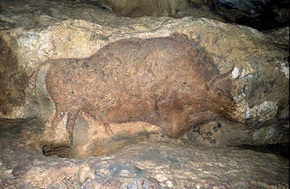
Font de Gaume is located in Dordogne, France (Hitchcock). It was first discovered in 1901 (Encyclopedia Britannica). The cave is open to tourists. They have recently renovated the ground for tourists. Before doing that, they studied the walls again to be sure they didn’t miss any paintings. The cave paintings are not only painted but are carved. If the paint disappears, most of the carving can still be seen. They discovered about 180 new images from animals to simple signs. Most of them are behind a layer of calcite and can be seen only with a UV or IR light (Hitchcock).
The cave has several side passages. There are about 230 engraved and painted figures, including 82 bison, horses, mammoths, reindeer, a wolf, and a woolly rhinoceros. The most famous images are of a leaping horse and a reindeer licking the forehead of a female (Encyclopedia Britannica).
The cave has several side passages. There are about 230 engraved and painted figures, including 82 bison, horses, mammoths, reindeer, a wolf, and a woolly rhinoceros. The most famous images are of a leaping horse and a reindeer licking the forehead of a female (Encyclopedia Britannica).
Altamira Cave
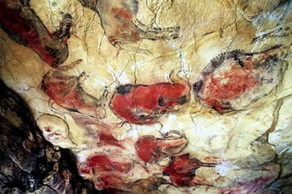
Altamira is the first discovered of the caves. It is located in Cantabria, Spain. It is known for its Upper Paleolithic cave paintings. They feature drawings and polychrome rock paintings of wild mammals and human hands. In the 19th century, people did not believe that prehistoric man had the intellectual capacity to produce any kind of artistic expression. Nowadays, that belief has been proven wrong. During that time, people decided that Altamira was the first to have prehistoric cave paintings discovered. However, other people believed that was wrong from prehistoric man’s lack of ability. The cave includes a variety of twisting passages and chambers. The cave was formed through collapses that followed early Karstic phenomena in the calcerous rock of Mount Vispieres. They used charcoal and ochre or hematite to create the images (Altamira (cave)).
They scratched and diluted the dyes to produce variances in intensity and created an impression of chiaroscuro.Chiaroscuro They also exploited the natural contours in the cave walls to give a three dimensional effect to their subjects. The Polychrome Ceiling is the most impressive feature. It shows a herd of bison in different poses, two horses, a large doe, and a possible wild boar. Solutrean images include images of horses, goats, and handprints from the artist placing his hand on the cave wall and spraying paint over it, leaving a negative image of his palm. Many of the other caves in northern Spain contain Paleolithic art but none of the others are as advanced or well-populated as Altamira (Altamira (cave)).
They scratched and diluted the dyes to produce variances in intensity and created an impression of chiaroscuro.Chiaroscuro They also exploited the natural contours in the cave walls to give a three dimensional effect to their subjects. The Polychrome Ceiling is the most impressive feature. It shows a herd of bison in different poses, two horses, a large doe, and a possible wild boar. Solutrean images include images of horses, goats, and handprints from the artist placing his hand on the cave wall and spraying paint over it, leaving a negative image of his palm. Many of the other caves in northern Spain contain Paleolithic art but none of the others are as advanced or well-populated as Altamira (Altamira (cave)).
Cosquer Cave
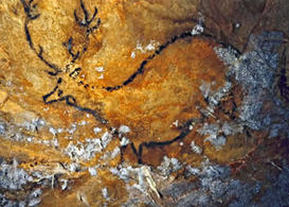
Cosquer Cave. What appears to be an image of a deer.
Cosquer cave is located deep under the sea. It is in Marseille, France. It was discovered in 1985 by a diver. The original entrance is located 115 feet below modern day sea level. The paintings were not mentioned until 1991. This is because three divers died when they got lost in the cave. The gallery slopes up for about 360 feet under water. It then, reaches a huge chamber that partly remained above the sea. The chamber is home to many prehistoric paintings and engravings are preserved on the walls. There are also remains of charcoal from fires and torches and a few flint tools on the ground. Cosquer cave is the only painted cave in the world with an entrance that is below present-day sea level. The cave art has been preserved from the flooding that occurred when the seas rose after the end of the last glaciation. There had been no previous Paleolithic art found in the area. There have been more than 150 animal figures found. In the east side of the chamber, there are a total of 65 hand stencils found. There was also one stencil found in the south side. There have only been adult hand stencils found (Clottes). This cave is the most unique. It can only be accessed by diving.
Definitions
Calcareous
Calcite
Chiaroscuro
Glaciation
Hematite
Karstic
Polychrome
Speleology
Secretions
Calcite
Chiaroscuro
Glaciation
Hematite
Karstic
Polychrome
Speleology
Secretions
-Composed of, containing, or characteristic of calcium carbonate, calcium, or limestone. Chalky.
-A common crystalline form of natural calcium carbonate that is the basic constituent of limestone, marble, or chalk.
-A technique of using light and shade in pictoral presentation.
-To cover with ice or a glacier.
-A redish brown the black rhombohedral mineral.
-An area of irregular limestone.
-Having many various colors.
-The scientific study of caves.
-The process of secreting a substance.
-A common crystalline form of natural calcium carbonate that is the basic constituent of limestone, marble, or chalk.
-A technique of using light and shade in pictoral presentation.
-To cover with ice or a glacier.
-A redish brown the black rhombohedral mineral.
-An area of irregular limestone.
-Having many various colors.
-The scientific study of caves.
-The process of secreting a substance.
